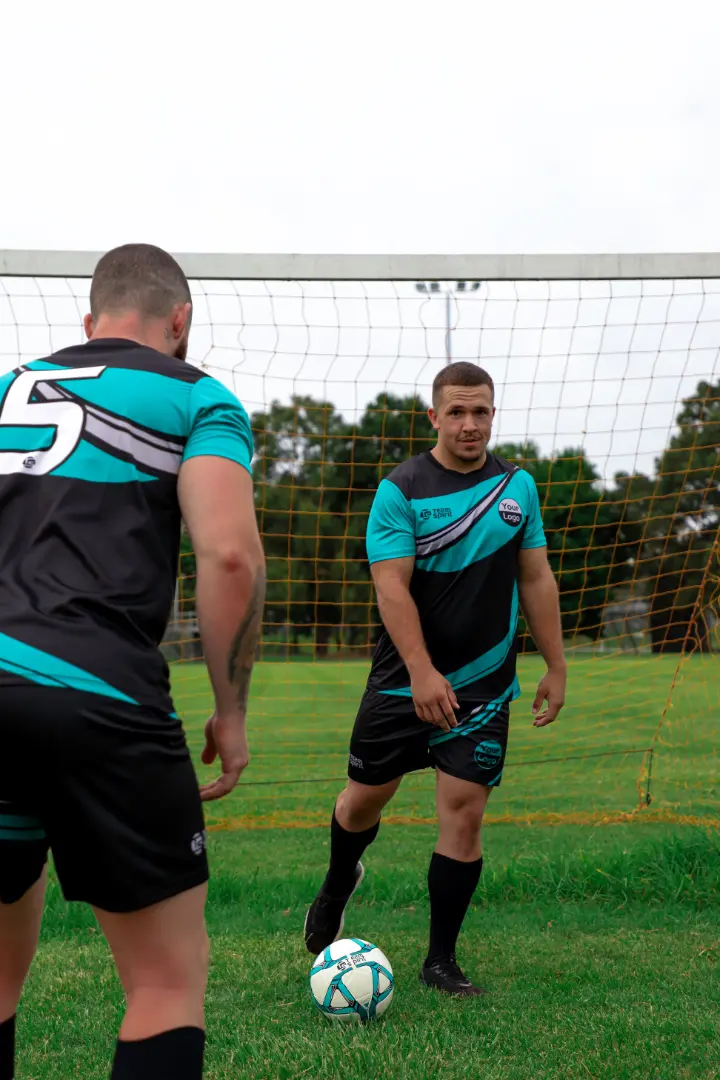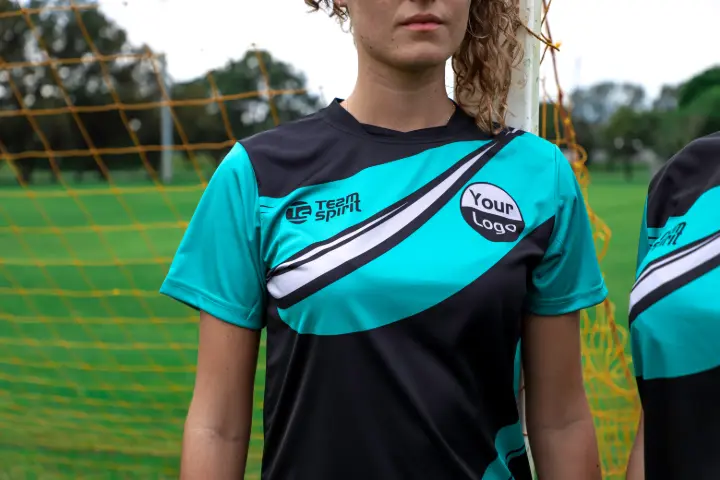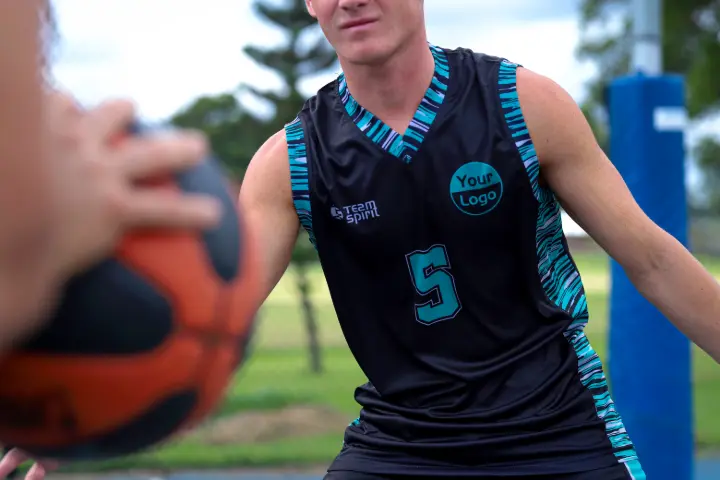Washing sportswear might seem straightforward, but active fabrics and sublimated prints need more than just a quick spin in the machine. Whether you're dealing with school PE kits, custom team uniforms, or everyday gym clothes, caring for them properly helps preserve their shape, stretch, and style.
In this guide, we’ll walk you through exactly how to wash sportswear, from sorting and pre-treating stains to choosing the right detergent and drying method. With the right approach, you can keep your gear fresh, functional, and ready for the next session.
Washing Tips by Fabric: Polyester, Sublimation & Compression Gear

Getting the most out of your sportswear starts with understanding what it’s made of. Each fabric commonly used in teamwear and activewear has its own strengths and care requirements. Whether you're dealing with sublimated team polos, polyester training shirts, or compression leggings, knowing the fabric is key to learning how to wash sportswear properly and ensuring you dry and store it the right way too.
Polyester and Mesh Blends
Polyester is the workhorse of modern sportswear. Lightweight, durable, and quick-drying, it’s often blended with mesh to improve breathability, making it ideal for jerseys, training tops, and custom team kits. Mesh zones (often found under arms or down the sides) help regulate body temperature during high-intensity activity.
To keep polyester and mesh gear performing well:
-
Always wash in cold water to avoid weakening the fibres.
- Use a gentle cycle to prevent snags.
- Avoid hot dryers, which can lead to pilling or fabric shrinkage.
Proper care helps maintain the structure of the garment and ensures it continues to wick away sweat effectively, essential for keeping athletes comfortable.
Sublimated Prints
Sublimation printing is a popular technique for custom sportswear because it allows bold, full-colour designs that won’t peel or crack. The process involves heat-pressing dye directly into the fabric fibres, usually on polyester.
Because the ink becomes part of the fabric, sublimated sportswear is more durable than traditional screen prints, but only if it’s cared for correctly.
To protect sublimated prints:
-
Wash inside out to shield designs from abrasion.
- Use cold water only to prevent colour fading.
- Avoid fabric softeners and harsh detergents, which can dull the print.
Sublimated gear, like netball dresses or AFL guernseys, stays vibrant longer when treated gently, making it perfect for team branding that stands out.
Elastane (Spandex) and Compression Materials
Found in compression shorts, tights, and stretch-fit tops, elastane (also known as spandex or Lycra) provides flexibility and muscle support during activity. These garments are tight-fitting and designed to move with the body, but they're also delicate.
To preserve the elasticity:
-
Hand wash or use a gentle machine cycle in cold water.
-
Avoid wringing out the fabric, which can damage stretch fibres.
-
Never tumble dry; flat dry to help the item keep its shape.
Washing too roughly or with heat breaks down the fibres, leading to sagging or loss of support, reducing the benefits of compression gear over time.
Cotton and Cotton Blends
Cotton is still used in casual sportswear, such as warm-up tops, branded schoolwear, or track pants. While soft and breathable, cotton isn’t as moisture-wicking or quick-drying as polyester and it’s prone to shrinking if washed incorrectly.
To care for cotton garments:
-
Wash in cold or lukewarm water on a gentle cycle.
-
Avoid high-heat drying, which causes shrinkage and stiffness.
- Use a mild detergent to maintain softness and shape.
For cotton-blend items, always check the care label, they may have additional properties like added stretch or water resistance that require extra attention.
How to Prep Sportswear Before Washing

Reading Care Labels
Before tossing your sportswear into the wash, take a moment to check the care labels. These small tags hold big clues, offering specific instructions on water temperature, wash cycle, and drying methods. Symbols like a hand in a bucket (hand wash only), crossed-out dryer icons (do not tumble dry), or triangle outlines (bleach guidance) help prevent damage. Understanding these instructions is a key part of how to wash sportswear correctly, especially when caring for sublimated prints and performance fabrics common in activewear and team uniforms.
Sorting Laundry
Don’t mix your jerseys with your jeans. To protect your sportswear and preserve colour and fabric integrity:
- Separate lights from darks to avoid dye transfer.
-
Group together similar fabric types, e.g., polyester with polyester, cotton with cotton.
-
Sort by soil level where needed, especially for muddy football kits or grass-stained polos.
This step also helps prevent abrasive damage from rougher garments rubbing against lightweight performance gear.
Read more: How to Wash a Jersey Properly
Turning Garments Inside Out
Turning your sportswear inside out before washing reduces friction on printed logos, embroidered details, and moisture-wicking surfaces. This small action helps protect:
-
Sublimated logos from fading
-
Mesh or perforated panels from pilling
- Reflective prints or heat transfers from peeling or cracking
This is especially crucial for custom teamwear and school sports uniforms with branding that needs to stay sharp for longer.
Pre-Treating Stains and Odours
For stubborn sweat odours or visible marks, pre-treatment goes a long way. Here’s how to handle common issues:
-
Odours: Soak garments in a mixture of water and white vinegar (1:4 ratio) for 15–30 minutes before washing.
-
Sweat stains: Apply a paste of baking soda and water directly onto the underarm area, leave for 10–15 minutes, then wash.
-
Grass or dirt stains: Use a gentle stain remover or pre-wash spray and scrub lightly before placing in the machine.
Taking the time to treat spots early helps maintain the appearance and freshness of your gear, especially if you’re dealing with PE uniforms, rugby kits, or school sports polos.
Washing Sportswear: Detergents, Settings & Techniques
Machine Washing
When machine washing sportswear and custom team uniforms, the goal is to clean thoroughly without degrading the fabric or print.
- Use cold water to prevent shrinking and colour bleeding.
- Select a gentle or activewear cycle to reduce wear and tear.
- Place delicate items like compression shorts or sublimated jerseys in mesh laundry bags to prevent snags.
- Avoid overloading the machine, sportswear needs space to move for effective rinsing and odour removal.
This method works best for most modern sports fabrics like polyester, spandex blends, and moisture-wicking performance wear.
Hand Washing
For fragile items or heavily soiled garments, hand washing is still the gold standard.
-
Fill a basin with cold water and add a small amount of mild, sports-specific detergent.
- Soak items for 15–30 minutes, gently agitating the water to release sweat and dirt.
- Rinse thoroughly with cool water and squeeze (don’t wring) to remove excess moisture.
Hand washing is particularly recommended for sublimated prints, stretchy activewear, or uniforms with delicate stitching.
Detergent Selection
The detergent you use can make or break your sportswear’s longevity.
-
Opt for mild, enzyme-free detergents formulated for sportswear or delicates.
-
Avoid fabric softeners, they leave behind residue that clogs the fibres of moisture-wicking fabrics, reducing breathability and causing odours to linger.
-
Never use bleach, which can degrade colours, damage sublimation prints, and irritate sensitive skin.
A detergent made for activewear will help remove sweat without compromising stretch, shape, or colour, keeping your gear fresh for longer.
How to Dry Sportswear Without Damaging the Fabric
Air Drying vs. Machine Drying
When it comes to drying sportswear, air drying is always the safest bet. It helps maintain fabric performance, prevents shrinkage, and protects printed logos or heat-transferred graphics. Hanging your gear on a clothes rack or line (ideally out of direct sunlight) allows garments to dry evenly without the damage that can be caused by high heat.
Using a dryer, especially on sublimated or synthetic teamwear, poses several risks:
-
High heat can break down elastic fibres, especially in compression gear and stretch fabrics.
-
Logos and prints may crack, peel, or fade over time.
- Shrinkage can occur, particularly with blended or cotton-based fabrics.
If you must use a dryer, choose a low heat or air-dry setting, and remove garments while they’re still slightly damp to air-finish drying.
Drying Techniques
-
Flat drying is best for compression garments or anything with stretch. Lay the item flat on a clean, dry towel to help maintain its shape.
-
For most jerseys and polos, hang drying on padded or wide hangers will prevent shoulder bumps and help maintain the garment’s form.
-
Avoid using wire hangers or pegs that stretch or deform delicate materials.
Storage Tips
-
Make sure all items are completely dry before storing to prevent mildew and lingering odours.
-
Avoid storing in direct sunlight, as UV exposure can fade team colours, especially on sublimated prints or darker jerseys.
- For seasonal kits, consider folding and storing in breathable fabric bags rather than airtight plastic containers.
Proper drying and storage keep your custom sportswear looking newer for longer, preserving both comfort and team pride.
Special Care for Printed, Compression & Smelly Sportswear

Maintaining Sublimated and Printed Logos
Sublimated uniforms and printed logos require extra care to keep them crisp and vibrant.
-
Always wash garments inside out to reduce abrasion on the design.
-
Avoid rough surfaces (like Velcro or zippers) that can cause peeling or scuffing during the wash.
- Never expose sublimated gear to high heat, either in washing or drying, as it can cause fading or distortion.
Preserving logo integrity is especially important for team kits, school uniforms, and branded training gear.
Odour Control Strategies
Regular washing is key, but so is the right method. Odour build-up happens when sweat and bacteria get trapped in performance fabrics, especially if they’re not washed promptly.
To manage odours:
-
Stick to a consistent washing routine, especially after training or games.
-
Use odour-neutralising detergents or add a splash of white vinegar to your rinse cycle.
- Avoid fabric softeners, as they coat fibres and trap bacteria and smell.
These small changes can keep even your most-used training tops fresh between wears.
Extending Garment Lifespan
-
Rotate uniforms regularly to avoid excessive wear on a single set.
-
Tackle stains immediately, whether it’s grass, blood, or mud, letting them set makes removal harder and weakens fabric over time.
-
Repair minor damage like small tears or loose seams before they worsen.
Good care practices can significantly extend the life of PE kits, rugby jerseys, compression wear, and other custom garments, saving money and reducing waste.
Top Sportswear Laundry Mistakes (And How to Avoid Them)
Even the best gear can wear out quickly if not handled properly. Here are some mistakes to watch for:
-
Using too much detergent: Leads to residue build-up, which can clog fibres, reduce breathability, and hold in odours.
-
Not sorting laundry properly: Mixing fabrics or colours can cause colour bleeding or pilling, especially on performance gear.
- Overdrying or using high heat settings: A common reason for shrinking, warping, and logo damage.
- Ignoring care labels:Each item may have unique requirements, especially for blended fabrics or sublimated kits.
Avoiding these mistakes helps maintain the fit, feel, and performance of your sportswear, whether it's part of a school uniform set or high-performance training gear.
Keep Your Sportswear Performing With the Right Care
Knowing how to wash sportswear properly isn’t just about removing sweat, it’s about preserving the fabric, fit, and feel of your gear for the long haul. From understanding the right way to clean sublimated prints and compression garments, to choosing the best detergents and drying methods, a few simple habits can make a big difference.
By following the tips in this guide, you’ll protect your team uniforms from shrinking, fading, and odours, ensuring they look sharp and perform well season after season.
Looking for high-quality, easy-care custom sportswear for your school, club, or organisation? Team Spirit Sports offers durable, sublimated uniforms made to handle real-life wear and tear. Get in touch today to explore your options.